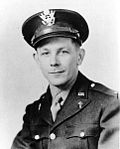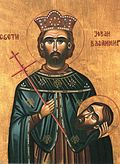Wikipedia:WikiProject Military history/News/November 2011/Articles
Appearance
|
New featured articles |

- Chaplain–Medic massacre (Ed!)
- The Chaplain–Medic massacre was a , the wounded were discovered by a North Korean patrol. Though the medic was able to escape, the North Koreans executed the unarmed chaplain as he prayed over the wounded, then killed the rest of them. The massacre was one of several incidents that led US commanders to establish a commission in July to investigate war crimes. The same month, the North Korean commanders, concerned about the way their soldiers were treating prisoners of war, laid out stricter guidelines for handling enemy captives.
- HMS Courageous (50) (Sturmvogel 66)
- HMS Courageous (Second World Warin September 1939. Courageous was torpedoed and sunk in the opening weeks of the war, going down with more than 500 of her crew.

- HMS Eagle (1918) (Sturmvogel 66)
- HMS Eagle was an early South Atlantic. After completing a major refit in early 1942, the ship made multiple trips delivering fighter aircraft to Malta to boost its air defences in the first half of 1942. Eagle was torpedoed and sunk by the German submarine U-73 on 11 August 1942 while escorting a convoy to Malta during Operation Pedestal.

- Jovan Vladimir (VVVladimir)
- Jovan Vladimir or John Vladimir (died 1016) was ruler of , and attract many believers, especially on his feast day, when the relics are taken to the church near Elbasan for a celebration.
New A-Class articles |

- Battle of Masan (Ed!)
- The Battle of Masan was an engagement between coordinated offensive across the entire perimeter. In delaying and pushing back the North Koreans, the 25th Infantry Division was able to buy time for UN forces to counterattack at Inchon, effectively defeating the North Korean Army at the Pusan Perimeter.

- De Lackner HZ-1 Aerocycle (The Bushranger)
- The De Lackner HZ-1 Aerocycle, also known as the YHO-2 and by the manufacturer's designation DH-4 Heli-Vector, was an American one-man "personal infantrymen, and after a pair of crashes the project was abandoned. A single model of the craft was put on display.

- George Andrew Davis, Jr. (Ed!)
- George Andrew Davis, Jr. (1920–1952) was a US MiG-15fighters, downing two before himself being shot down and killed. This controversial action earned him the Medal of Honor. With a total of 21 victories, Davis is one of only seven US military pilots to have become an ace in two wars, and one of only 31 to gather more than 20 victories. He was the fourth highest-scoring ace of the Korean War.

- HMS Hermes (95) (Sturmvogel 66)
- HMS Hermes was an Ceylon. After the raid on Colombo on 5 April by the Japanese, Hermes was sent to Trincomalee, but had left the harbour when the Japanese attacked it on 9 April. She was spotted near Batticaloaby a Japanese scout plane and then attacked by several dozen dive bombers; 307 men were lost in the attack.

- List of ironclad warships of Germany (Parsecboy)
- Between the mid 1860s and the early 1880s, the pre-dreadnought battleships, though other historians have used the term more generally, especially in relation to the small armored ships operated by the US Navy during the American Civil War. The rival Danish fleet had three ironclads in service by the time the Second Schleswig War broke out in 1864; as a result, Prussia purchased the ironclads Arminius and Prinz Adalbert, which entered service by 1865. The Prussian Navy acquired three more ships—Friedrich Carl, Kronprinz, and König Wilhelm—by the outbreak of the Franco-Prussian War in 1870. A fourth would not be completed in time to see service during the war. In 1871, the various Germanic states were unified under Prussian dominance as the German Empire; the Prussian Navy became the core of the Imperial Navy. The three turret ships of the Preussen class were built in Germany in the early 1870s, followed by two Kaiser-class vessels, the last capital ships ordered from foreign yards. The next design, the four Sachsen-class ships, was intended to operate from fortified bases against a naval blockade, not on the high seas. The last German ironclad was another new design, Oldenburg, before the Navy instead began to focus on torpedo boatsfor coastal defense.
- List of Knight's Cross of the Iron Cross recipients (T) (MisterBee1966)
- The recipients in the military forces of allies of the Third Reich. The 7,322 recipients are listed in the 1986 edition of Walther-Peer Fellgiebel's book, [Die Träger des Ritterkreuzes des Eisernen Kreuzes 1939–1945] Error: {{Lang}}: text has italic markup (help) — The Bearers of the Knight's Cross of the Iron Cross 1939–1945. In 1996 a second edition was published with an addendum delisting nine of these original 7,323 recipients. Author and historian Veit Scherzer has cast doubt on a further 192 of these listings. The majority of the disputed recipients had received the award in 1945, when the deteriorating situation of the Third Reich during the final days of World War II left a number of nominations incomplete and pending in various stages of the approval process.

- Thomas Blamey (Hawkeye7)
- Chief of the General Staff, and was involved in the creation of the Royal Australian Air Force. He resigned from the regular Army in 1925 to become Chief Commissioner of the Victoria Police, but remained in the Militia. He resigned from the police in 1936 following two scandals. During the first years of the Second World War he commanded the Second Australian Imperial Force and I Corps in the Middle East. In 1942, Blamey returned to Australia as Commander in Chief of the Australian Military Forces and Commander of Allied Land Forces in the South West Pacific Area. He oversaw several successful campaigns, including a series of controversial offensives in the last months of the war. Blamey signed the instrument of surrender on behalf of Australia at Japan's ceremonial surrender in Tokyo Bay on 3 September 1945, and later personally accepted the Japanese surrender at Morotai. He was promoted to field marshal in June 1950.

